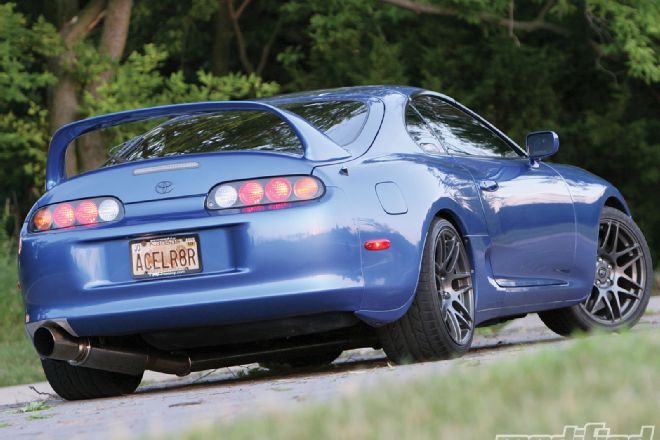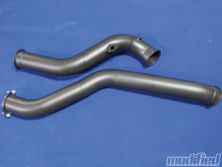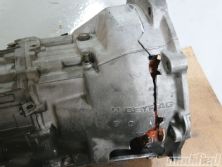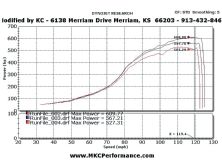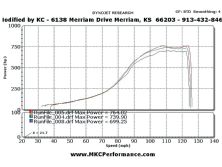For modified turbocharged cars pushing 300 to 600 whp, the most common exhaust size seems to be 3-inch. Some big-turbo cars use 4 inches at the expense of increased noise and decreased ground clearances, which is enough to deter many away from the larger-diameter piping. With piping sizing becoming more diverse, the option to go to a 3.5-inch diameter is now a viable choice. Experts say a 3-inch exhaust is fine for sub-800-whp levels like our Toyota Supra test car, but how much is being left on the table?
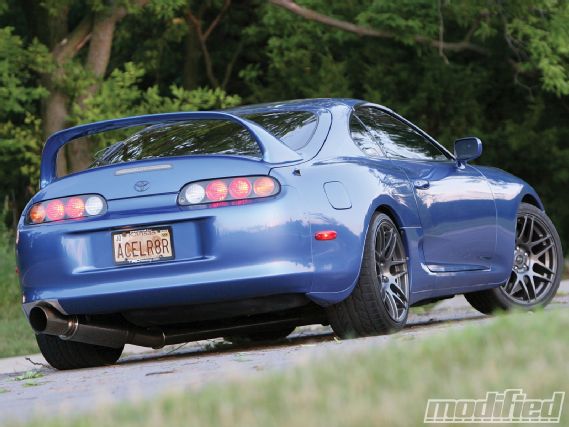 |
3-Inch Vs. 3.5-inch Exhaust Test - Tech
|
3-Inch Vs. 3.5-inch Exhaust Test - Tech
While a half-inch may not sound like much, it equates to a 36 percent increase in volume, and we wanted to find out if there's actually a real-world difference. We also compared a 3.5-inch open dump wastegate system against our current 3-inch recirculated piping to see how well the additional flow would aid in reaching peak boost.
3.5-inch Exhaust Test (Downpipe back)
Modified by KC in Kansas City was kind enough to build our 3.5-inch exhaust and let us perform our testing on its Dynojet 424x, with pump fuel maps with methanol injection. Using 304 stainless tubing and a 3.5-inch, free-flow muffler (including a 5-inch tip from MagnaFlow), MKC fabricated the entire exhaust system from the existing 3-inch downpipe on the car.
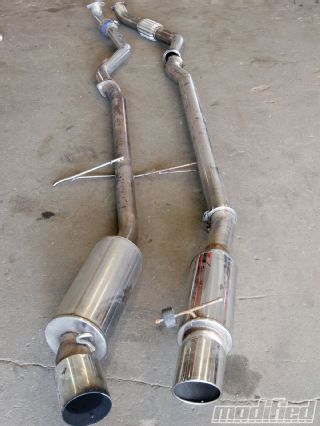 |
The 3-inch exhaust (left) versus the MKC/MagnaFlow 3.5-inch system (right). This test alone netted gains of 66 whp and 52 whp at 19 psi and 29 psi, respectively.
|
The 3-inch exhaust (left) versus the MKC/MagnaFlow 3.5-inch system (right). This test alone netted gains of 66 whp and 52 whp at 19 psi and 29 psi, respectively.
Once fired up, the new exhaust clearly displayed a deeper tone at idle, but thankfully, it was only marginally louder. We wanted to perform this first test without increasing downpipe size simply out of curiosity, but we weren't expecting significant gains.
Our 3-inch exhaust baseline netted 527 whp at 19 psi. With the 3.5-inch exhaust, it climbed to 567 whp with a peak gain of 66 whp at 6000 rpm in fourth gear. At 29 psi, we went from a baseline of 699 to 740 whp. Peak gains here were 52 whp at 6100 rpm. The icing on the cake is the fact the turbo spools up a 150-200 rpm quicker with the larger-diameter exhaust.
3.5-inch Downpipe Test (Full Exhaust)
Fabricating a custom downpipe on a Supra with the engine still in the car is a tedious and costly job. And while there are a few outfits with 4-inch setups, 3.5-inch is almost nonexistent. Fortunately, our friends at Powerhouse Racing (PHR) in Texas sell a 3.5-inch downpipe and mid-pipe specifically for HKS-style manifolds, the same used on our SP turbo kit.
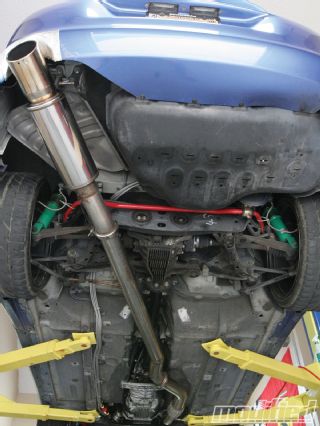 |
Surprisingly, the 3.5-inch system fits nice and snug against the Supra's underbody.
|
Surprisingly, the 3.5-inch system fits nice and snug against the Supra's underbody.
The PHR system is sold complete with hardware and black Extreme 2000 HPC coating to cope with the heat. Each kit also includes a Toyota Oxygen sensor two-bolt flange and wideband sensor bung with ceramic coating and V-band flanges. Since it is a true 3.5-inch system and our turbocharger's housing exit is 3-inch, MKC fit an inch-long 3.0- to 3.5-inch "step-up" with 3-inch V-band to fit the turbo housing.
With the short bottleneck still at the turbo exit, our expectations weren't optimistic - once again, we were pleasantly surprised. Although gains didn't start until the exhaust was flowing at least 500 whp, at 19psi we hit 610 whp with a peak gain of 52 whp at 7000 rpm from the downpipe alone. Compared to our baseline, at this boost setting, the entire exhaust system is netting a whopping 103-whp gain!
Setting the boost back up to 29 psi, the larger 3.5-inch system started to expose the octane limits of our engine with pump fuel still coursing through its veins. At 764 whp, the AEM EMS pulled a couple of degrees of timing up top, limiting the gains to 30 whp at 6100 rpm. Still, compared to our first baseline, our total gain was now up to 70 whp at 6100 rpm with the full 3.5-inch exhaust. With a couple gallons of race fuel in the mix, surely we could have clipped the 775-whp mark.
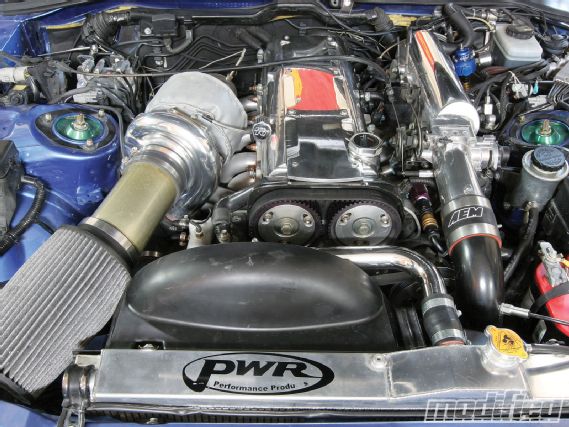 |
3-Inch Vs. 3.5-inch Exhaust Test - Tech
|
3-Inch Vs. 3.5-inch Exhaust Test - Tech
While many turbo cars out there use 3-inch exhausts, we've proven that a hefty amount of horses are left in the stable when doing so. In fact, with just the 3.5-inch rear section, 20-whp gains started as low as at the 300-whp level and kept climbing. With PHR's downpipe, those gains mattered more at 500 whp.
If there is one drawback, the new system is significantly louder during cruising with the MagnaFlow muffler. However, MagnaFlow does sell a small 3.5-inch resonator that would further reduce sound decibels if added. At wide-open throttle, the car isn't a whole lot louder, even with our open dump pipe. It's simply deeper and way more menacing.
With a better sound, more power and a quicker spool up, it's safe to say the move to 3.5-inch piping is a worthwhile modification to this Supra, and we'd expect it to help most other large turbo cars in this power range as well.
Clutch Woes on the Way to 700 whp Having suffered a clutch failure from a broken pressure plate strap a few years ago (which took out our costly transmission housing), we vowed never to use a strapped clutch again. We had to order a new transmission housing from Toyota World, which also rebuilt our 6-speed Getrag transmission, and we were still out a clutch.
Thankfully, we found a clutch that's really been working for us. The RPS billet twin carbon clutch uses a strapless pressure plate and features a machined billet aluminum cover. RPS reports this clutch to be 6 lbs lighter than a standard clutch, making it ideal for racing or drifting.
The RPS clutch has not only been problem-free for the past 4K miles, it's ultra-smooth engagement makes it extremely streetable, enough to allow you to parallel park on the streets of San Francisco. It also has a stock-like feel at the pedal, which isn't bad for a clutch rated to withstand 800 ft-lbs of torque - well north of the torque we're seeing.
Unfortunately, the dyno wasn't picking up the car's tachometer reading, so we couldn't plot power and torque over rpm. However, our peak torque reading in the 764-whp run was 630 ft-lbs.
80-120 MPH DYNO ACCELERATION, FOURTH GEAR BASELINE 3.5" EXHAUST 3.5 DP/EXH* 19 psi 2.54 seconds 2.54 seconds 2.24 seconds 29 psi 2.00 seconds 1.88 seconds 1.84 seconds *8 degrees (F) hotter that dayTest Notes
All runs were done within three days and an 8-degree Fahrenheit temperature variance, the hottest being the last day. We digitally monitored water and intake manifold air temperatures for accuracy and consistency. All runs were performed with no changes made to the tuning and using 93 octane with methanol injection for fuel.

